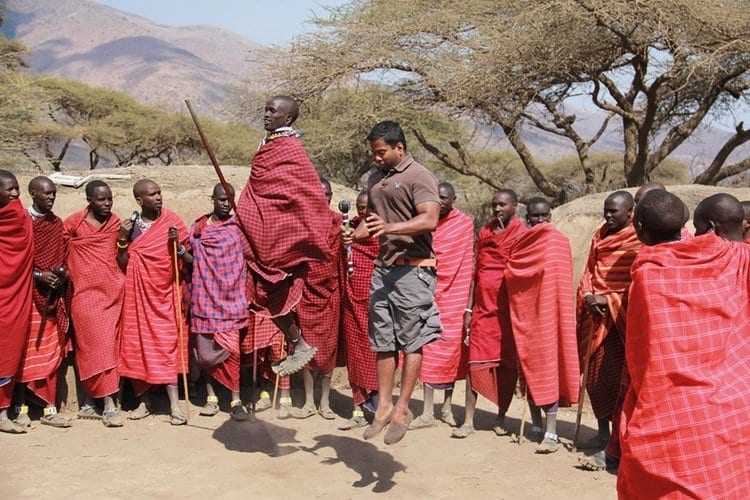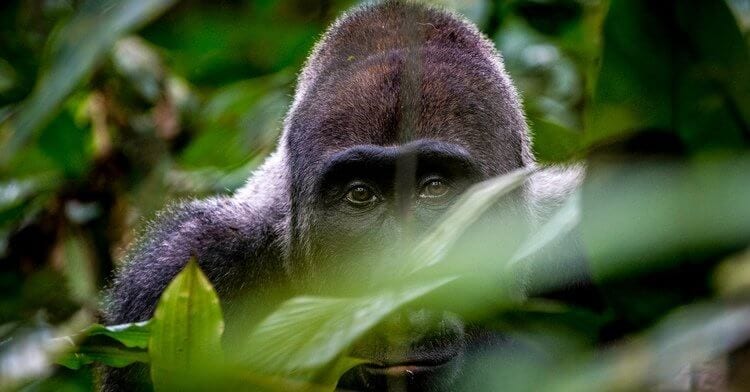
Essential Tanzania Safari Getaway
June 28, 2018
Experience Uganda’s gorillas in the mist in a new way
July 26, 2018
Essential Tanzania Safari Getaway
June 28, 2018
Experience Uganda’s gorillas in the mist in a new way
July 26, 2018

Most travellers have gorilla trekking on their bucket-list and if you don't this may change your mind and call for a trip to Rwanda.
Cast your mind back to 1988 when the movie 'Gorillas in the Mist' made its debut with the role of Dian Fossey played by a magnificent Sigourney Weaver. It is well worth a watch if you haven't. This movie was instrumental in educating most on the plight of the Gorillas in Rwanda and Uganda. Many documentaries have been made on these gentle giants of the forests in Africa and much is being done to conserve them.
Forward some 20 years to 2008 and it was about this time that Rwanda managed to solve its poaching problem, which affected the Gorilla population in a negative way.
The survival of villagers in Rwanda
For many years most villagers living in close proximity to the forests of Kiningi in the Northern Province of Rwanda were forced to set traps to catch buffalo, buck and other animals to survive and gorillas were collateral damage as a result.
The spin-off for tourism and the economy growing at six per cent annually as a result of Gorilla Trekking and travellers spending foreign currency in Rwanda, while on holiday.
Everything shouts gorillas in Rwanda, from the billboards to taxis and even on bank notes. Rwanda is a very small country with a dark history that it would dearly like to escape, but the economy has blossomed as a result of the gorillas in Rwanda. From genocide to peace and prosperity and the gorillas are set in the middle of it.
Villagers from the surrounding parks are given employment as trackers and guides, and even ex-poachers are rehabilitated and transformed into uniformed porters who carry luggage and camera bags around for trekkers. Tourist spend is also fed back into the local community to help develop infrastructure, like hospitals, clinics and schools.
Kwita Izina - Rwanda's annual gorilla naming ceremony
Kwita Izina is an annual ceremony held in Rwanda where dignitaries are invited to name the baby gorillas born during that preceding year. The surrounding villages are invited to a free music concert as well.
Children dress up in baby gorilla suits and the crowd cheers them on and the new names given to them too. If you speak to the locals they can all identify the different gorilla family names and they can relate a story about each.
All of this fosters a great sense of ownership and these people help protect gorillas, which is in stark contrast to what is happening in Uganda and the Congo.

Volcanoes National Park at the heart of Gorilla Trekking & Conservation
Dian Fossey established her observation camp between Mount Bisoke and Mount Karisimbi in 1967, and she predicted mountain gorillas would be extinct in the wild before the end of the century.
The numbers have grown from 242 in 1981 to an estimated 800 and even as high as 1000. At least this conservation story has a good tale to tell.
Beginning a gorilla trekking experience at the mountain foothills of Volcanoes National Park is a surreal experience. Being submerged in this pristine mountain forest stirs up so many emotions. At first, it is scary and daunting, which later morphs into exciting and exhilarating when you get a glance at your first gorilla. They are truly magnificent creatures.
Gorilla Trekking - A bucket-list item
Trekking parties are normally made up of people from all walks of life with a true sense of adventure and some who have waited a lifetime to experience the wonder of gorilla trekking. Rwanda is a magical place to experience this, especially because of them being held in such high regard by the locals.
Our guide who won the award for "Guide of the Year" has had the opportunity to go to the "big" city Kigali and even went on to visit Dubai and Tokyo. His eyes grow wide as he tells of his adventure which took him outside his village for the first time in his life. "Tokyo is nothing like Rwanda," he commented.
The air in the mountain forests is cool and moist with green light reflecting from the canopy. The canopy also rang with the sounds of tropical birds and some Golden Monkeys. All around you, you can feel the forest elephants and buffalo, but unfortunately, we did not see any up close.
Gorilla treks can end up being either short or quite long before you spot these gentle giants, all depending on where they are moving around on any given day.

Suddenly our guide stopped and pointed ahead of us at some shaking leaves and the next minute a bird darted from the foliage into the sky and then nothing. Our trackers shook their heads in disbelief. At one point we even contemplated what we would feel like if we don't find any gorillas on our trek. This was not long lived when our guide Emmanuel started making some low bellowing and grunting sounds and just ahead of us we spotted them.
We climbed a little more up the hillside, now oblivious to the pain the stinging nettles from the undergrowth were giving me. I was so overwhelmed with emotion I wanted to shout out, but everyone has to remain calm and you cannot make any loud sounds or sudden movements.
Soon the gorillas become accustomed to our human presence, even the big old silverback, who probably thinks these feeble creatures are in any case no match for me and not even worth it. He just gives a glance our way and then stares off into the distance as the king would over his precious lands. The gorillas get so close, but they are not allowed to touch us as the germs we carry that cause flu could kill gorillas. Our guide and trackers shy us away when they get too close. Just being in this situation was so surreal that it feels like it could be the set of a movie and the actors will jump out of their suits at any minute, but no - this is so real!
It almost feels like there is a connection between us and them, but they don't need us. We go on adventures like a gorilla trek to give our life meaning and meaning it definitely gives.
Would I do it again? In a heartbeat!
Getting to Rwanda
There are quite a number of options from London to Kigali in Rwanda. You have your choice of KLM via Amsterdam, Kenya Airways via Nairobi, Brussels Airlines via Brussels and British Airways (operated by Qatar Airways one way or both) via Nairobi or Doha. Each flight has varying stopovers with different waiting times, so please book carefully. Our suggestions are either KLM via Amsterdam or BA via Doha. Flying via Nairobi can prove to have its challenges.
The choices from the US include Delta via Amsterdam, KLM via Amsterdam or Turkish Airlines via Istanbul which all include one stopover and the return flights all have two stopovers with the first one in Entebbe in Uganda and onto Amsterdam or Istanbul. Again be sure to go with choices that have shorter flight times and stopover times.
We prefer to arrange all internal travelling in Rwanda to avoid any mishaps and problems.

What you need to know about Rwanda
Visa requirements for UK citizens: You need a visa to enter Rwanda. 30-day tourist visas are available on arrival for £20 or $30. You can pay in cash (sterling, US dollars or Rwandan francs) or by Visa/Mastercard. Payment by credit card may not be available at all land border crossings. The Rwandan Directorate General of Emigration and Immigration publishes a list of visa types and costs. For more information please visit this Government website.
Rwandan Visas for US citizens: All U.S. citizens visiting Rwanda must obtain a visa upon entry. Tourist visas, valid for 30 days, are available for purchase for $30 USD at Rwandan land borders and at Kigali International Airport. Acceptable forms of payment are U.S. dollars (printed during or after 2006), Rwandan francs, or Visa or MasterCard credit cards. We strongly recommend that you travel with U.S. dollars to pay for the visa fee in the case that credit card machines are not functional at the time of your arrival. To extend your tourist visa, you will need to visit the Rwandan Directorate General of Immigration and Emigration, located near the U.S. Embassy in Kigali. For more information visit the US Embassy in Rwanda website.
Best time to visit Rwanda for Gorilla Trekking
There are no distinct seasons in Rwanda, but gorillas tend to hide and find cover in the rainy season, very much like us. So it’s best to avoid the rainy seasons from March to May and October to November. The best time to visit is June to mid-September.

Where to go and where to stay
As mentioned before Volcanoes National Park is the best place to do gorilla trekking. Remember that a permit is required to go gorilla trekking and these now cost USD1500 compared to USD600 in Uganda.
Other places which are very much worth a visit are Nyungwe National Park, Akagera National Park and Lake Kivu. A trip to the Genocide Museum in Kigali is also a must see to experience Rwanda's past, present and future. Find out more on the Kigali Genocide Memorial here.
Some of the luxury lodges and camps that make our pick to stay at in Volcanoes National Park include the famous Bisate Lodge, as well as, Virunga Lodge. Mountain Gorilla View Lodge is our mid-range choice. High-end Sabyinyo Silverback Lodge is well situated for gorilla trekking and is part of a local Community Trust and does so much for socio-economic change and conservation initiatives in the local communities.
For Akagera we recommend Ruzizi Tented Camp and Karenge Bush Camp both offering a very authentic luxury bush camping experience. Lake Kivu Serena and Kigali Serena are our choices for Lake Kivu and Kigali respectively.
Ultimately there is a lot to consider and we would love to chat with you about all your choices and tailor make your next safari to Rwanda.




























